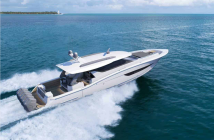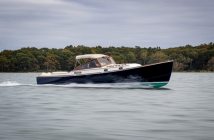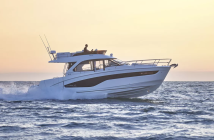Here are seven tips about how to prepare for your next cruise, even before you leave home, from Skipper Tips. Pour yourself a cup of coffee, or whatever, pull out your paper charts (oh, you think your GPS will work all the time?), and get ready for a safe cruise.
1. Mark Shoals and Set the Alarm!
Use a dark blue pencil to mark any shoal within one to two miles of your sailing tracks. Set your depth sounder alarm to trigger when you sail within a mile or so of any of these shoals. This will give you more time to change course toward deeper water for sailing safety.
2. Look for Ranges (Transits) for “Bulls-eye” Navigation.
Use ranges (also called “transits”)–two objects that line up with one another–to keep in the center of a channel. Look on your nautical chart and see if you can find two charted objects that line up with the waterway. Ranges (transits) make sailing easier and safer no matter where you sail!
3. Scan for Wrecks that Could Cause You Harm.
Use your magenta or crimson colored pencil to mark wrecks nearby. Realize that wrecks can shift position after storms or in strong currents. Plotted positions may not be accurate on older uncorrected charts. Keep nautical charts corrected and up-to-date with the latest Notices to Mariners. Click here to find out more about these valuable free resources => Notice to Mariners Info (see the lower part of the page for countries outside of the US).
4. Circle Emergency Anchorages to Stand Out.
Use a colored pencil to draw an anchor symbol surrounded by a circle to mark emergency anchorages near your sailing route. If you lose engine power in a narrow channel or you need to “pull off the road” when sailing along the coast, an emergency anchorage that’s already marked and highlighted provides a super-fast sailing solution day or night.
5. Darken or Highlight Lat/Long Scales for Faster Plotting.
Do you find the Latitude and Longitude scales difficult to read in low light conditions? Use a highlighter to make degrees and minutes stand out. You could use a fine tip laundry marking pen (waterproof) to darken the “tick marks” where the cartographer (chart maker) has written the degrees or degrees and minutes along the scale. Both techniques should help reduce eye strain and plotting errors.
6. Make a Customized Distance Scale.
Make your own distance scales for each coastal or inland chart. We used this technique in the US Coast Guard time and again with great success. Cut out a one inch by eight or ten-inch piece of heavy poster board (or similar stiff paper stock). Lay one long edge alongside the middle of the Latitude scale on your nautical chart.
Mark off distances in nautical miles and tenths. Use your laundry marker to make it stand out. Note at the top the specific chart scale (i.e. 1:80,000; 1:40,000). Tape over the scale to protect it. Your portable distance scale alleviates the need to go back and forth between your plotting area and the Latitude scale. This makes plotting distances faster and easier!
7. Form a “Box of Protection” Around Sailing Courses.
Imagine that your sailing track lies inside a four-sided rectangular shaped structure. Each side lies about two to three miles away from any point of the sailing track. Now, scan out to that distance from each side of this virtual “box of safety“. Do you see any rocks, wrecks, obstructions? How about notes that tell you of tide rips, breakers, or dangerous currents? Highlight any features that will help keep your small sailboat and sailing crew safe and sound. Read more:
https://www.skippertips.com/public/2631.cfm#




